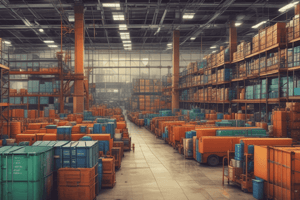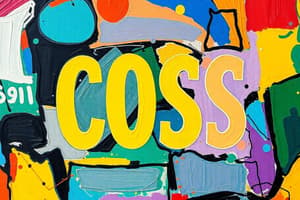Podcast
Questions and Answers
What is the formula to calculate the cost of one set of tooling (C1)?
What is the formula to calculate the cost of one set of tooling (C1)?
- $Ct * nt / N
- $Ct * N / nt
- $Ct / N (correct)
- $Ct / nt
What is the assumption for tooling in the calculation of C1?
What is the assumption for tooling in the calculation of C1?
- Tooling can be used for multiple projects
- Tooling is dedicated to the project
- Tooling can be used in series or parallel operations
- Both A and B (correct)
What is the purpose of Mold Classification by Lifetime?
What is the purpose of Mold Classification by Lifetime?
- To classify the quality and lifetime of molds (correct)
- To calculate the cost of one set of tooling
- To forecast the total production volume
- To determine the number of parts each tool set can make
What is the symbol 'N' represents in the formula for C1?
What is the symbol 'N' represents in the formula for C1?
What is the purpose of rounding up the result of C1 to the nearest integer?
What is the purpose of rounding up the result of C1 to the nearest integer?
What is the symbol 'nt' represents in the formula for C1?
What is the symbol 'nt' represents in the formula for C1?
What is the unit of measurement for 'Ct'?
What is the unit of measurement for 'Ct'?
What is the purpose of using the Society of Plastics Industry (SPI) classification system?
What is the purpose of using the Society of Plastics Industry (SPI) classification system?
What is the assumption for the calculation of C1 regarding tooling?
What is the assumption for the calculation of C1 regarding tooling?
What is the primary factor that determines the perceived value of a product to customers?
What is the primary factor that determines the perceived value of a product to customers?
Which of the following is NOT a contributor to overhead cost in manufacturing?
Which of the following is NOT a contributor to overhead cost in manufacturing?
What is the formula for calculating the total cost of making a part?
What is the formula for calculating the total cost of making a part?
What is the primary purpose of cost prediction in manufacturing?
What is the primary purpose of cost prediction in manufacturing?
Which of the following is an example of a variable cost in manufacturing?
Which of the following is an example of a variable cost in manufacturing?
What is the term for the maximum price that customers are willing to pay for a product?
What is the term for the maximum price that customers are willing to pay for a product?
What is the primary difference between manufacturing cost and product cost?
What is the primary difference between manufacturing cost and product cost?
What is the term for the process of calculating the total cost of making a part?
What is the term for the process of calculating the total cost of making a part?
Which of the following is NOT a factor that affects the cost of manufacturing a product?
Which of the following is NOT a factor that affects the cost of manufacturing a product?
Flashcards are hidden until you start studying
Study Notes
Manufacturing and Product Cost
- Manufacturing cost is affected by various factors, including material cost, equipment cost, tooling, labor, and overhead.
- Overhead costs include energy, equipment maintenance, and facilities upkeep.
Cost Ceiling Factors
- Perceived value of the product to customers affects the cost ceiling.
- Size of the market, competition, and brand equity also influence the cost ceiling.
Elements of Manufacturing Cost
- Material cost is a contributor to manufacturing cost.
- Equipment cost is another factor that affects manufacturing cost.
- Tooling, labor, and overhead costs also contribute to the overall manufacturing cost.
Total Cost of Making a Part (Ashby's Model)
- The total cost of making a part is the sum of fixed and variable costs.
- The cost equation is: 𝐶 = 𝐹 + 𝑉∗𝑁, where 𝐶 is the total cost, 𝐹 is the fixed cost, 𝑉 is the variable cost, and 𝑁 is the production quantity.
Cost Computation
- Fixed cost (F) and variable cost (V) are used to calculate the total cost (C).
- The cost per unit is calculated by dividing the total cost by the production quantity (N).
Tooling Cost
- The tooling cost equation is: 𝐶1 = 𝐶𝑡 ∗ 𝑅𝑜𝑢𝑛𝑑𝑢𝑝 (𝑁 / 𝑛𝑡), where 𝐶1 is the tooling cost, 𝐶𝑡 is the cost of one set of tooling, 𝑁 is the total forecast production volume, and 𝑛𝑡 is the number of parts each tool set can make before wearing out.
- Tooling cost is affected by the production volume and the number of parts each tool set can make before wearing out.
Studying That Suits You
Use AI to generate personalized quizzes and flashcards to suit your learning preferences.



